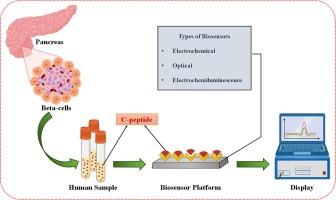Detecting C-peptide using biosensors for diagnosis and monitoring of disease
IF 4.9
2区 化学
Q1 CHEMISTRY, ANALYTICAL
引用次数: 0
Abstract
The connecting peptide (C-peptide) is a short polypeptide that connects the A-chain to the B-chain in the proinsulin molecule. This biomarker is secreted into the blood circulation in the same amount as insulin and has a longer half-life than it. Measuring blood serum levels of C-peptide can be used to distinguish between different diabetes types. Also, the amount of C-peptide in body fluids as an indicator has been used to evaluate pancreatic beta‐cell function. However, a reliable and fast method is essential to quantify the amount of C-peptide in biological fluids and its significance in the control and diagnosis of disease. Over the years, several studies have used biosensors to detect C-peptide levels in real samples. These studies focused on speeding up detection and creating novel detection techniques. Biosensor-based methods can potentially improve the diagnosis and monitoring of diabetes. This review aims to provide a general overview of the various C-peptide biosensors in relation to their detection limit and potential point-of-care uses.

使用生物传感器检测 C 肽,用于诊断和监测疾病
连接肽(C-肽)是连接胰岛素分子中 A 链和 B 链的短多肽。这种生物标志物分泌到血液循环中的量与胰岛素相同,但半衰期比胰岛素长。测量血清中的 C 肽水平可用于区分不同的糖尿病类型。此外,体液中的 C 肽含量也被用作评估胰岛β细胞功能的指标。然而,要量化生物体液中的 C 肽含量及其在疾病控制和诊断中的意义,必须要有一种可靠而快速的方法。多年来,已有多项研究使用生物传感器检测真实样本中的 C 肽水平。这些研究的重点是加快检测速度和开发新型检测技术。基于生物传感器的方法有可能改善糖尿病的诊断和监测。本综述旨在概述各种 C 肽生物传感器的检测极限和潜在的护理点用途。
本文章由计算机程序翻译,如有差异,请以英文原文为准。
求助全文
约1分钟内获得全文
求助全文
来源期刊

Microchemical Journal
化学-分析化学
CiteScore
8.70
自引率
8.30%
发文量
1131
审稿时长
1.9 months
期刊介绍:
The Microchemical Journal is a peer reviewed journal devoted to all aspects and phases of analytical chemistry and chemical analysis. The Microchemical Journal publishes articles which are at the forefront of modern analytical chemistry and cover innovations in the techniques to the finest possible limits. This includes fundamental aspects, instrumentation, new developments, innovative and novel methods and applications including environmental and clinical field.
Traditional classical analytical methods such as spectrophotometry and titrimetry as well as established instrumentation methods such as flame and graphite furnace atomic absorption spectrometry, gas chromatography, and modified glassy or carbon electrode electrochemical methods will be considered, provided they show significant improvements and novelty compared to the established methods.
 求助内容:
求助内容: 应助结果提醒方式:
应助结果提醒方式:


